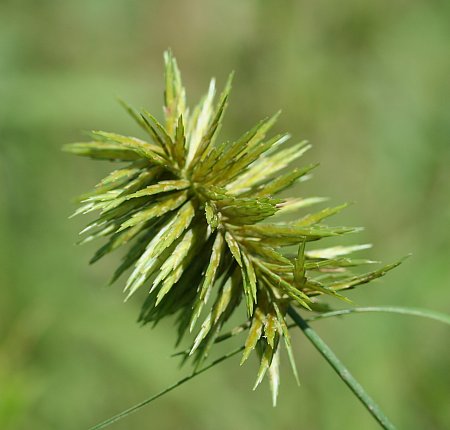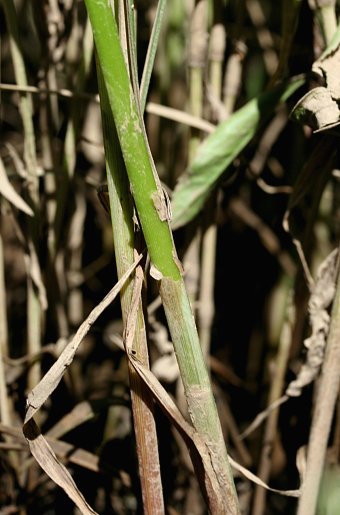Description: This perennial flatsedge is ½–3' tall and unbranched. The culm is 3-angled, glabrous, and rather stout. A few leaves develop along the lower half of the culm; their blades are 4-18"' long and 2-10 mm. across, medium green, and glabrous. There is a deep furrow along the central midrib of most leaf blades. The lower leaves often wither away before flowering occurs. The inflorescence consists of an umbel or compound umbel of floral spikes; a typical umbel spans 2-5" across. A typical inflorescence consists of 1-2 sessile spikes and 3-5 spikes on stiff peduncles (or rays) up to 4" long. Some of these spikes may have 1-2 lateral spikes projecting from each of their bases; these lateral spikes are shorter. At the base of the inflorescence, there are 3-8 leafy bracts that are as long as the leaf blades and very similar in appearance. These bracts ascend slightly upward at the base and are widely spreading; some of these bracts extend beyond the inflorescence. The floral spikes are about ¾–2" long and short-cylindrical in shape; they consist of 30-80 linear-flattened spikelets that extend more or less perpendicularly from the central rachises of the spikes in all directions. This provides each spike with a bottle-brush appearance.

Each greenish
yellow spikelet is about 12-20 mm. (½–¾") in length and 1-2 mm. across,
consisting of about 5-11 florets and their scales. The florets and
their scales are arranged in 2 overlapping ranks along the length of
each spikelet;
they become less green and more straw-colored or light brown with
maturity. Each scale
is glabrous, lanceolate with a pointed tip, and sharply curved
(with a keel) along the
middle of its length, where a green midvein occurs. The length of each
scale is 3-6 mm. Each floret has an ovary, a tripartite style, and 3
stamens.
The blooming period occurs during the summer or autumn. The florets are
cross-pollinated by the wind. Afterwards, the florets are replaced
by oblongoid achenes that are
1.5–2.0 mm. in length and bluntly 3-angled; there is one
achene per floret. The root system consists of a
corm-like swelling at the base of the plant, shallow fibrous roots, and
spreading rhizomes. Clonal colonies of plants can develop from the
rhizomes.
Cultivation:
The preference is full sun and moist to wet conditions. This flatsedge
readily adapts to soil that is muddy, sandy, or gravelly. The size of
this flatsedge is highly variable, depending on the fertility of the
soil and the age of individual plants. Because of its heat-
and drought-resistant C4 metabolism, most growth and development occur
during the summer.

Range &
Habitat:
Straw-colored Flatsedge has been found in every county of Illinois,
where it is native and common (see Distribution
Map). Habitats include low areas along ponds and rivers,
sloughs
and prairie swales, seeps, sedge meadows, ditches along roads and
railroads, fallow fields, and poorly maintained gardens. These habitats
can be either sandy or non-sandy. Straw-colored Flatsedge prefers
sunny seasonal wetlands with a history of disturbance, although it is
also found in higher quality wetlands. Sometimes it becomes a weed in
fields and gardens.
Faunal Associations:
Larvae of the Flatsedge Borer Moth (Diploschizia impigritella)
bore into the stems and leaf bases of flatsedges (Cyperus spp.).
Other insect feeders include larvae of the Sedge Gall Midge (Planetella
caudata), the Yellow Sugar Cane Aphid (Sipha flava), the
Viburnum-Sedge
Aphid (Ceruraphis
eriophori), and the Blissid bug, Ischnodemus rufipes.
The value of Straw-colored
Flatsedge to vertebrate wildlife is less
than Yellow Nut Sedge (Cyperus esculentus) because
its root system lacks tubers. However, such wetland birds as the
Green-winged Teal, Blue-winged Teal, Northern Pintail, Northern
Shoveler, Canada Goose,
Redwing Blackbird, and Bobolink eat the seeds or seedheads of this
and other flatsedges; the Canada Goose also eats the foliage. Cattle
are able to browse on the
foliage of flatsedges without ill effects, but it is not regarded as
high quality forage.

Photographic
Location:
A drainage ditch in Urbana, Illinois.
Comments:
This is one of the larger flatsedges (Cyperus spp.)
in Illinois; it is rather variable across its range. Individual plants
of Straw-colored Flatsedge (Cyperus
strigosus) can become 3' tall, but this is unusual.
More typically, individual
plants are ¾–2' tall. The floral spikelets of Straw-colored Flatsedge
are green to yellowish green when they are immature. In contrast,
the common Yellow Nut Sedge (Cyperus esculentus) has
immature spikelets that are pale yellow to golden
yellow. The floral scales of Straw-colored Flatsedge are unusually long
and slender (easily exceeding 3.5 mm. in length) and they are
relatively few in number (about 5-11) per spikelet. Similar flatsedges
have shorter floral scales (less than 3.5 mm. in length) and they are
often (but not always) more numerous per spikelet (easily exceeding 12
or more). Another common name of Cyperus
strigosus is Umbrella Flatsedge.